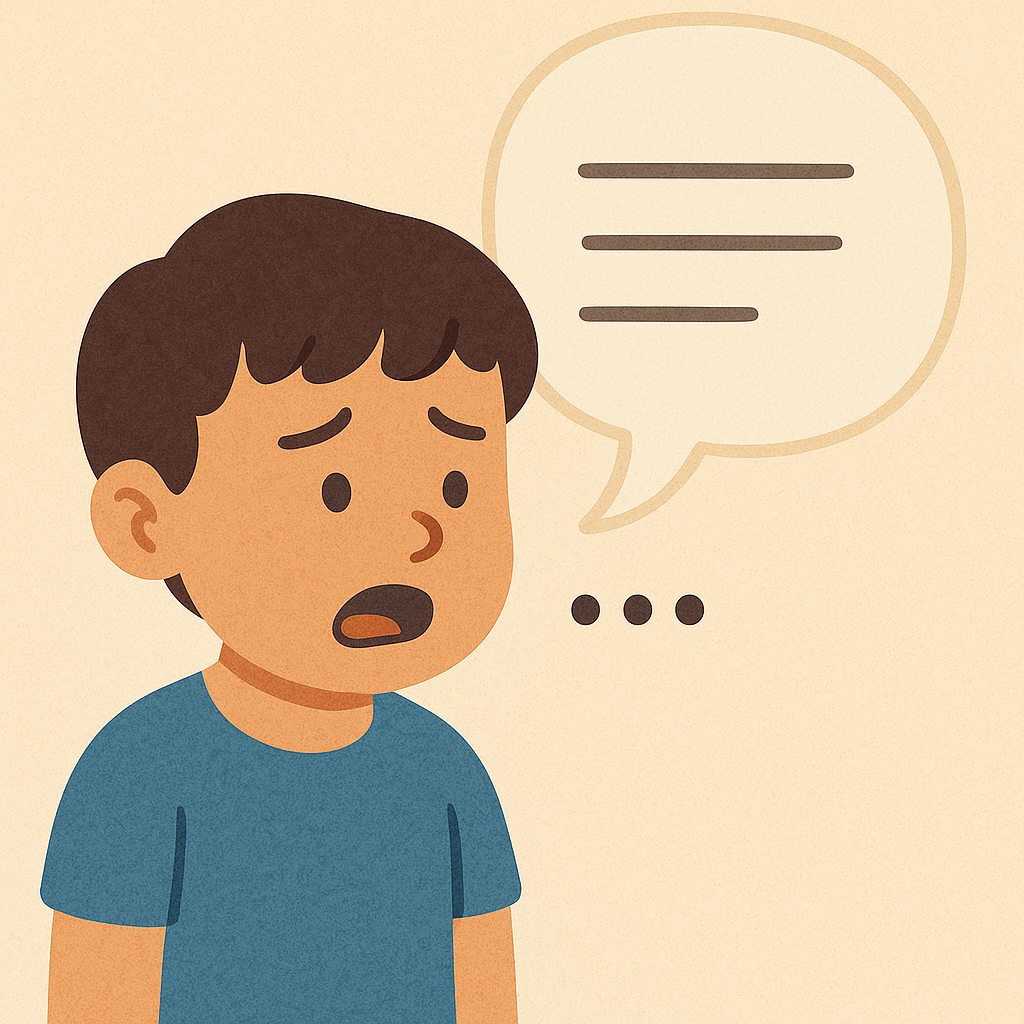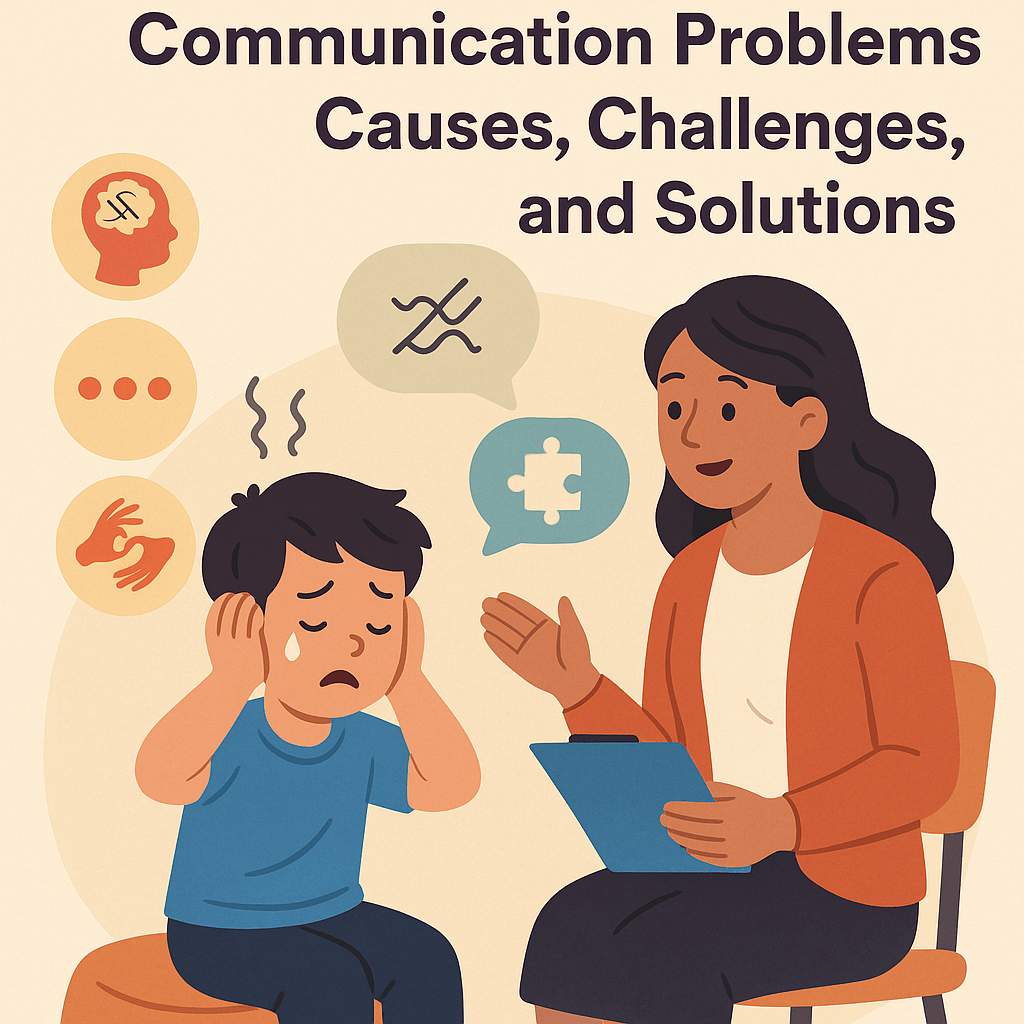Are you exhausted seeing your child’s autism-related communication problems persist even after months of speech therapy?
You see your child struggling to express needs, make eye contact, or use words consistently.
You might feel that the progress is slow because communication in autism is more than speech sounds. In fact, it is about how your child processes language, tackles sensory input, and learns social cues.
So while treating you, you need to focus on these foundations alongside speech work. When these aspects are overlooked, it will be hard for you to achieve the expected outcomes.
Once you understand the cause of why communication is not improving, it helps you set clearer goals with your therapist. This also allows you to make simple home routines (modeling, visual supports, AAC) and a coordinated plan that aligns sensory, language, and social learning, so your child can communicate more comfortably and you can breathe a little easier.
Connect with our autism experts today to understand what therapies may suit your child best.
What are the causes of communication struggles in autism

Most autistic kids have communication issues. Children experience delayed speech, trouble finding the right words, or challenges in expressing even their basic needs.
For some children, the issue goes deeper, because to communicate, they may rely on gestures or remain nonverbal. This will make their everyday interactions a real challenge for both you and your child. These communication issues related to autistic children can affect even simple tasks like asking for water or building friendships.
Even after starting speech therapy, progress may not be immediate because communication in autism depends on many factors:
- Neurological wiring: Your child’s brain processes language differently, making it harder to understand and use words.
- Sensory sensitivities: A noisy environment can overwhelm a child, shutting down their ability to focus on speech.
- Social differences: Picking up on facial expressions, gestures, or tone of voice isn’t automatic, so engaging in back-and-forth conversation requires extra effort.
- Anxiety and stress: Pressure to “perform” in therapy or at school can sometimes hold a child back and create anxiety and stress instead of helping.
Parent Tip: If you are aware of these root causes, it helps you set realistic expectations. The child would still need therapy. But it often works best when paired with supportive strategies at home, patience, and alternative communication methods, such as visual aids or AAC devices.
👉 Get a personalized plan for your child if you feel therapy alone is not giving results.
Why speech therapy alone may not be enough?
You may be thinking of speech therapy as the first step to help your child communicate better and overcome speech delay. There is no doubt that speech therapy can be highly beneficial, but you should know that it may not address the challenge on its own.
Speech therapy focuses on verbal skills, articulation, and language development. But children with autism have other communication issues. For example:
- Sensory processing issues: A child may get overwhelmed by sounds, lights, or touch, which makes it harder to focus on therapy.
- Social communication difficulties: They may have issues with how to start conversations, maintain eye contact, or understand body language.
- Behavioral and emotional challenges: They may also have anxiety, rigidity, or repetitive behaviors that can interfere with progress in sessions.
That’s the reason why some parents feel frustrated when they see speech therapy not working properly. It may not be due to the ineffectiveness of the therapy. Instead, it may be because speech therapy alone cannot address the broader needs of the child.
But that doesn’t mean you need to think that the child cannot improve their communication skills. It means they need a more comprehensive approach.
You can get better outcomes by combining speech therapy with occupational therapy, behavioral interventions, and social skills training, which can lead to more effective therapeutic outcomes.
You will see meaningful progress in your child only when the treatment or therapy targets both the verbal and nonverbal aspects of communication.
How can you support your child at home?
Here are some tips that you can use at home to improve your child’s communication:
1. Use a simple visual schedule for daily routines
Children with autism find it hard to process spoken instructions. Moreover, when there is too much information in the instructions, it becomes complex for them. So creating a visual schedule is a better idea.
These visual schedules break tasks into clear, predictable steps and reduce the child’s anxiety. When they are stress-free and calm, they understand what happens next clearly.
Here’s how you create a visual schedule:
- Create a picture chart showing steps for daily routines like breakfast, brushing teeth, or bedtime.
- Use real photos or simple icons. For example, a plate for breakfast and a toothbrush for brushing teeth.
- Place the chart at eye level where your child can see it.
- Each time a step is completed, let your child move a marker or turn over the picture to show progress.
Following this, you can create a bedtime routine or breakfast routine. Another example to help you understand.
- Take a bath (picture of bathtub)
- Put on pajamas (picture of pajamas)
- Brush teeth (picture of toothbrush)
- Storytime (picture of a book)
- Sleep (picture of a bed)
Because of this routine, the child begins to anticipate and follow the scheduled task without much resistance, which reduces meltdowns and confusion.
2. Practice One Skill at a Time
If you introduce many communication goals at one time, your child may get confused. Focusing on one skill at a time helps them master it completely.
Here’s how you can do it:
- Choose one skill for the week, like requesting a favorite toy using words, gestures, or pictures.
- You need to create opportunities to hone the skill throughout the day. You can keep the toy in sight but out of reach so your child has to request it.
- When your child attempts to communicate (even if imperfectly), model the correct word or phrase and reward them by giving them the toy.
You can say, “Do you want the ball? Say ‘ball.’”
When the child says, “Ball!” (or attempts to say it), you should reward them by saying, “Great job! Here’s the ball!”
This exercise helps the child gain confidence in using that one word or phrase and feel motivated to communicate because it leads to a positive result.
3. Use odeling and Parallel Talk
All children learn language by hearing it used naturally in real-life situations. You can help them connect language to meaning by modeling words and narrating actions.
You can do it this way:
- When playing, describe what you or the child is doing: “You are building a tower!”
- Use short, simple sentences repeatedly so the child hears key words often.
- Pair words with gestures or objects to reinforce meaning.
For example, you are trying this method while playing blocks. You say, “Block. Red block. Put the block on top.” Your child watches or imitates action. This practice will help your child associate words with actions and objects. This will also lay the ground for speech and comprehension.
4. Use visual choices for communication
If your child is struggling with speech, giving them visual options is a way to help them communicate without pressure and reduce frustration.
How to do it:
- Show two pictures: one of milk, one of water.
- Ask them, “What do you want?”
- The child may point to the picture, and when they do that,, you need to say the word. Now you need to give them the item.
You can follow this example. Ask your child, “Do you want milk or water?” Your child may point to to the milk picture now. You would say, “Milk! Here is your milk.”
Through this practice, your child begins to associate pictures with words and understands they can get their needs met by communicating, even if it’s nonverbal.
5. Make communication practice a daily routine
Practicing better communication should not be separated as a “therapy time.” Adding it to your daily life makes learning natural and stress-free.
You can make it a part of your daily routine using these steps:
- During meals: Encourage the child to request food items by name.
- During play: Pause mid-game so the child signals to continue.
- During dressing: Offer two shirt options so the child can make a choice.
Here’s how you can apply these steps to your daily life. Ask your child, “Do you want an apple or a banana?” If the child says, “Apple,” you should give them the apple and say, “Here is the apple.”
As a parent, you would need a lot of patience, and also you should remember that whatever you do at home, you need personalized treatments and therapies and expert guidance to speed up the improvements and get expected results.
How can a combination of therapies boost progress?
Most parents start their child’s treatment with allopathy and ABA therapy. Around 70%-80% of parents first consult a neurologist and start ABA sessions. These treatments give results in some children, but many of them need to wait longer to see any visible outcomes.
Truth be told, there is nothing wrong with this path. But if you want to accelerate your child’s overall growth and progress, you may need to consider an approach that is not single-stream.
Why do you need to consider combination therapy?
Whether it is allopathy, Ayurveda, or homeopathy, all treatments have their strengths. Each of them is designed to focus on making them efficient at managing their daily activities, which means there is no such thing as a 100% guaranteed result.
Combination therapy can make a difference by bringing together the best qualities of all these treatments on one table. It can also give your child faster and more sustained progress.
Every child with autism needs a personalized plan because their problems and challenges are different. Most children begin with therapies like ABA (Applied Behavior Analysis) and speech therapy, which are proven to improve communication, behavior, and social skills over time.
Parents and doctors may choose to add other supportive options after evaluating their child’s challenges and progress.
For example, stem cell therapy can be considered when traditional therapies alone are not enough, as it has shown promise in reducing hyperactivity, improving eye contact, and supporting speech in some children. The right mix of therapies always depends on your child’s symptoms and needs.
How can you support your child’s communication
Therapies and treatment options mentioned above are used to help children overcome language problems, social interaction, and daily communication skills. These therapies build the foundation for children with autism who experience speech delay.
It will not improve overnight, but when combination therapy is used, it improves communication and encourages meaningful conversation.
Combination therapy can boost your child’s communication skills. This is not compulsory for your child, but doctors may consider it when progress needs an extra boost.
Remember, the right plan is always tailored to your child’s unique needs.
Takeaway
You will be able to help your child communicate better when you realize the fact that communication in children with autism is more than speech sounds. You need to focus on their sensory, social, and emotional foundations too.
Therapies like ABA and speech therapy are essential, but combining approaches can give you a better result. Combination therapy brings together speech, behavioral, and supportive medical sciences, and that’s how it can help your child move forward faster.
It may take time, but with the right plan, you’ll start to see small improvements that build into bigger changes and allow your child to express themselves with more comfort and confidence.
If your child is facing communication challenges even after treatment, consult an autism specialist or explore our combination therapy program designed to support faster, more holistic outcomes.
Frequently asked questions
Q1. What is the best age to start speech therapy for a child with autism?
The earlier, the better. Many specialists suggest beginning therapy as soon as speech delays are noticed, which mostly happens around 18 months to 2 years. Early intervention is important for your child to lay a stronger foundation.
Q2. Can only speech therapy improve my child’s communication?
Speech therapy is important, but many children also benefit from ABA, occupational therapy, or sensory integration therapy. In some cases, combination therapy works better because it addresses multiple challenges together.
Q3. Is stem cell therapy necessary for all children with autism?
No. It is not necessary for all children with autism. But the care team may consider it in special cases where other treatments and therapies are not working well.
Q4. How long will it take to see improvement in my child’s communication?
It won’t be the same for all children. Some children will show improvements in communication faster than others. You need to be consistent with the therapies and patient, and also the right combination of therapies may make the progress much faster.
- https://www.nidcd.nih.gov/health/autism-spectrum-disorder-communication-problems-children
- https://pmc.ncbi.nlm.nih.gov/articles/PMC4492467/
- https://www.mastermindbehavior.com/post/autism-noise-sensitivity#:~:text=For%20those%20with%20autism%2C%20this,%2C%20educational%20environments%2C%20or%20workplaces.
- https://pmc.ncbi.nlm.nih.gov/articles/PMC2997252/
- https://pmc.ncbi.nlm.nih.gov/articles/PMC8356281/
- https://www.nidcd.nih.gov/health/autism-spectrum-disorder-communication-problems-children
- https://www.medicoexperts.com/neurology/autism/
- https://www.medicoexperts.com/neurology/autism/treatment-options/
- https://www.medicoexperts.com/infantile-autism/
- https://www.medicoexperts.com/neurology/autism/treatment-options/combination-therapy/
- https://www.medicoexperts.com/neurology/autism/types-of-autism/
Recommendations to understand different treatments
Medically Reviewed by MedicoExperts Editorial & Clinical Review Board




